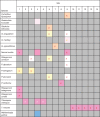Matching floral and pollinator traits through guild convergence and pollinator ecotype formation
- PMID: 24052557
- PMCID: PMC3890386
- DOI: 10.1093/aob/mct203
Matching floral and pollinator traits through guild convergence and pollinator ecotype formation
Abstract
Background and aims: Pollinator landscapes, as determined by pollinator morphology/behaviour, can vary inter- or intraspecifically, imposing divergent selective pressures and leading to geographically divergent floral ecotypes. Assemblages of plants pollinated by the same pollinator (pollinator guilds) should exhibit convergence of floral traits because they are exposed to similar selective pressures. Both convergence and the formation of pollination ecotypes should lead to matching of traits among plants and their pollinators.
Methods: We examined 17 floral guild members pollinated in all or part of their range by Prosoeca longipennis, a long-proboscid fly with geographic variation in tongue length. Attractive floral traits such as colour, and nectar properties were recorded in populations across the range of each species. The length of floral reproductive parts, a mechanical fit trait, was recorded in each population to assess possible correlation with the mouthparts of the local pollinator. A multiple regression analysis was used to determine whether pollinators or abiotic factors provided the best explanation for variation in floral traits, and pollinator shifts were recorded in extralimital guild member populations.
Key results: Nine of the 17 species were visited by alternative pollinator species in other parts of their ranges, and these displayed differences in mechanical fit and attractive traits, suggesting putative pollination ecotypes. Plants pollinated by P. longipennis were similar in colour throughout the pollinator range. Tube length of floral guild members co-varied with the proboscis length of P. longipennis.
Conclusions: Pollinator shifts have resulted in geographically divergent pollinator ecotypes across the ranges of several guild members. However, within sites, unrelated plants pollinated by P. longipennis are similar in the length of their floral parts, most probably as a result of convergent evolution in response to pollinator morphology. Both of these lines of evidence suggest that pollinators play an important role in selecting for certain floral traits.
Keywords: Coevolution; Prosoeca longipennis; ecotype; floral guild; geographic variation; pollination; proboscis length; specialization; speciation; trait matching; tube length.
Figures







Similar articles
-
Do pollinator distributions underlie the evolution of pollination ecotypes in the Cape shrub Erica plukenetii?Ann Bot. 2014 Jan;113(2):301-15. doi: 10.1093/aob/mct193. Epub 2013 Sep 26. Ann Bot. 2014. PMID: 24071499 Free PMC article.
-
Floral adaptation to local pollinator guilds in a terrestrial orchid.Ann Bot. 2014 Jan;113(2):289-300. doi: 10.1093/aob/mct219. Epub 2013 Oct 9. Ann Bot. 2014. PMID: 24107683 Free PMC article.
-
A test of the Grant-Stebbins pollinator-shift model of floral evolution.New Phytol. 2025 Mar;245(5):2322-2335. doi: 10.1111/nph.20373. Epub 2025 Jan 10. New Phytol. 2025. PMID: 39794298 Free PMC article.
-
Floral isolation, specialized pollination, and pollinator behavior in orchids.Annu Rev Entomol. 2009;54:425-46. doi: 10.1146/annurev.ento.54.110807.090603. Annu Rev Entomol. 2009. PMID: 19067636 Review.
-
Pollination ecotypes and the origin of plant species.Proc Biol Sci. 2025 Jan;292(2039):20242787. doi: 10.1098/rspb.2024.2787. Epub 2025 Jan 29. Proc Biol Sci. 2025. PMID: 39876736 Free PMC article. Review.
Cited by
-
Patterns of floral morphology in relation to climate and floral visitors.Ann Bot. 2020 Mar 9;125(3):433-445. doi: 10.1093/aob/mcz172. Ann Bot. 2020. PMID: 31650169 Free PMC article.
-
Floral and mating system divergence in secondary sympatry: testing an alternative hypothesis to reinforcement in Clarkia.Ann Bot. 2014 Jan;113(2):223-35. doi: 10.1093/aob/mct218. Epub 2013 Sep 29. Ann Bot. 2014. PMID: 24081279 Free PMC article.
-
Plant-pollinator interactions along the pathway to paternity.Ann Bot. 2019 Jan 23;123(2):225-245. doi: 10.1093/aob/mcy167. Ann Bot. 2019. PMID: 30535041 Free PMC article. Review.
-
Trade-off mitigation: a conceptual framework for understanding floral adaptation in multispecies interactions.Biol Rev Camb Philos Soc. 2021 Oct;96(5):2258-2280. doi: 10.1111/brv.12754. Epub 2021 Jun 7. Biol Rev Camb Philos Soc. 2021. PMID: 34096158 Free PMC article.
-
What maintains variation in flower accessibility to pollinators in plant communities? A simulation study.BMC Ecol Evol. 2025 May 9;25(1):45. doi: 10.1186/s12862-025-02380-0. BMC Ecol Evol. 2025. PMID: 40346488 Free PMC article.
References
-
- Anderson B, Johnson SD. The geographical mosaic of coevolution in a plant pollinator mutualism. Evolution. 2008;62:220–225. - PubMed
-
- Anderson B, Johnson SD. Geographical covariation of flower depth in a guild of fly pollinated plants. New Phytologist. 2009;182:533–540. - PubMed
-
- Anderson B, Johnson SD, Carbutt C. Exploitation of a specialized mutualism by a deceptive orchid. American Journal of Botany. 2005;92:1342–1349. - PubMed
-
- Anderson B, Alexandersson R, Johnson SD. Evolution and coexistence of pollination ecotypes in an African Gladiolus (Iridaceae) Evolution. 2010;64:960–972. - PubMed
Publication types
MeSH terms
Substances
LinkOut - more resources
Full Text Sources
Other Literature Sources

